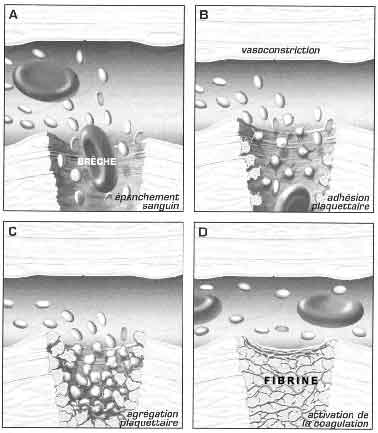Hemostasis is the body's normal physiological response for the prevention and stopping of bleeding/hemorrhage. It results in the blocking of any vascular rupture. Generally speaking, it helps ensure blood fluidity and blood vessel integrity. Abnormalities in hemostasis can result in bleeding (hemorrhage) or blood clots (thrombosis).
Hemostasis consists of:
- Primary Hemostasis:
- Local vascular contraction (to reduce blood flow to the injury site)
- platelet plug formation
- Local vascular contraction (to reduce blood flow to the injury site)
- Secondary Hemostasis:
- Clotting of the plasma (secondary hemostasis), involving interactions between numerous factors and inhibitors.
- Clotting of the plasma (secondary hemostasis), involving interactions between numerous factors and inhibitors.
- Fibrinolysis
- Process for removing the clot once blood vessel integrity has been restored.
When there is a rupture in a blood vessel, the first priority is to arrest blood loss. The main players in the blood are the platelets and fibrinogen, which act to form a platelet plug.

Figure 1: Formation of the clot. (Source: Introduction à l'étude de l'hémostase et de la thrombose - B. Boneu, J-P. Cazenave - 1997) Bleeding at the site of the vascular injury is stopped by the formation of an extravascular clot. An injury causes a transitory vasoconstriction of the small blood vessels reducing blood flow. Platelets stick to the sub-endothelial tissue at the site of injury and finally they aggregate together. Initiation of coagulation leads to the formation of fibrin, which helps stabilize this clot and stop bleeding.
Brêche = Breach
Epanchement sanguin = Bleed/hemorrhage
Aggrégation plaquettaire = platelet aggregation
Adhésion plaquettaire = platelet adhesion
Activation de la coagulation = activation of coagulation
Fibrine = fibrin
Following this first step, the formation of a clot stops any further bleeding. This process consists of a series of chemical reactions involving various plasma components. To date 10 major coagulation factors are known to be involved in this process. These complex interactions lead to the transformation of fibrinogen fibrin. As part of the wound healing process, fibrinolysis dissolves the clot.
Abnormalities in Coagulation
Coagulation abnormalities are diagnosed by laboratory examination of the blood coagulation process, either by using a global test (clotting time), an analytical test (looking specifically at the different components of coagulation) or by a blood count (the amount of hemoglobin and the number of white cells, red cells and platelets per cubic millimeter of blood).
Some of these tests can also be used to measure the effect of any anticoagulant treatment that is given to treat or reduce the risk of thrombosis. Diagnostica Stago develops and designs equipment and different test methods used in the laboratory to measure and allow better understanding of coagulation/hemostasis.
